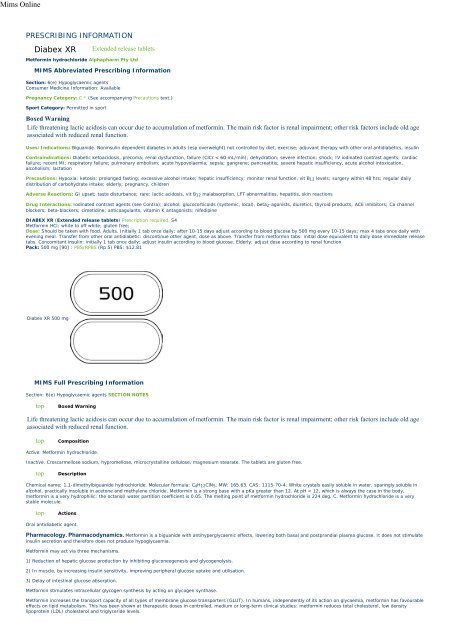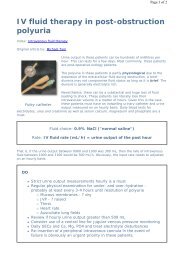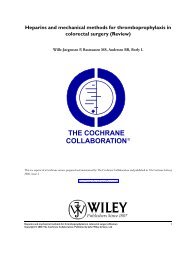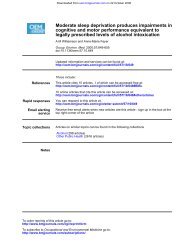Diabex XR (metformin hydrochloride extended ... - The Medicine Box
Diabex XR (metformin hydrochloride extended ... - The Medicine Box
Diabex XR (metformin hydrochloride extended ... - The Medicine Box
Create successful ePaper yourself
Turn your PDF publications into a flip-book with our unique Google optimized e-Paper software.
Mims OnlinePRESCRIBING INFORMATION<strong>Diabex</strong> <strong>XR</strong>Extended release tabletsMetformin <strong>hydrochloride</strong> Alphapharm Pty LtdMIMS Abbreviated Prescribing InformationSection: 6(e) Hypoglycaemic agentsConsumer <strong>Medicine</strong> Information: AvailablePregnancy Category: C * (See accompanying Precautions text.)Sport Category: Permitted in sport<strong>Box</strong>ed WarningLife threatening lactic acidosis can occur due to accumulation of <strong>metformin</strong>. <strong>The</strong> main risk factor is renal impairment; other risk factors include old ageassociated with reduced renal function.Uses/Indications: Biguanide. Noninsulin dependent diabetes in adults (esp overweight) not controlled by diet, exercise; adjuvant therapy with other oral antidiabetics, insulinContraindications: Diabetic ketoacidosis, precoma; renal dysfunction, failure (ClCr < 60 mL/min); dehydration; severe infection; shock; IV iodinated contrast agents; cardiacfailure; recent MI; respiratory failure; pulmonary embolism; acute hypovolaemia; sepsis; gangrene; pancreatitis; severe hepatic insufficiency, acute alcohol intoxication,alcoholism; lactationPrecautions: Hypoxia; ketosis; prolonged fasting; excessive alcohol intake; hepatic insufficiency; monitor renal function, vit B 12 levels; surgery within 48 hrs; regular dailydistribution of carbohydrate intake; elderly; pregnancy, childrenAdverse Reactions: GI upset; taste disturbance; rare: lactic acidosis, vit B 12 malabsorption, LFT abnormalities, hepatitis, skin reactionsDrug Interactions: Iodinated contrast agents (see Contra); alcohol; glucocorticoids (systemic, local), beta 2-agonists, diuretics, thyroid products; ACE inhibitors; Ca channelblockers; beta-blockers; cimetidine; anticoagulants, vitamin K antagonists; nifedipineDIABEX <strong>XR</strong> (Extended release tablets) Prescription required. S4Metformin HCl; white to off white; gluten free;Dose: Should be taken with food. Adults. Initially 1 tab once daily; after 10-15 days adjust according to blood glucose by 500 mg every 10-15 days; max 4 tabs once daily withevening meal. Transfer from other oral antidiabetic: discontinue other agent, dose as above. Transfer from <strong>metformin</strong> tabs: initial dose equivalent to daily dose immediate releasetabs. Concomitant insulin: initially 1 tab once daily; adjust insulin according to blood glucose. Elderly: adjust dose according to renal functionPack: 500 mg [90] : PBS/RPBS (Rp 5) PBS: $12.81<strong>Diabex</strong> <strong>XR</strong> 500 mgMIMS Full Prescribing InformationSection: 6(e) Hypoglycaemic agents SECTION NOTEStop<strong>Box</strong>ed WarningLife threatening lactic acidosis can occur due to accumulation of <strong>metformin</strong>. <strong>The</strong> main risk factor is renal impairment; other risk factors include old ageassociated with reduced renal function.topCompositionActive. Metformin <strong>hydrochloride</strong>.Inactive. Croscarmellose sodium, hypromellose, microcrystalline cellulose, magnesium stearate. <strong>The</strong> tablets are gluten free.topDescriptionChemical name: 1,1-dimethylbiguanide <strong>hydrochloride</strong>. Molecular formula: C 4H 12ClN 5. MW: 165.63. CAS: 1115-70-4. White crystals easily soluble in water, sparingly soluble inalcohol, practically insoluble in acetone and methylene chloride. Metformin is a strong base with a pKa greater than 12. At pH < 12, which is always the case in the body,<strong>metformin</strong> is a very hydrophilic: the octanol/ water partition coefficient is 0.05. <strong>The</strong> melting point of <strong>metformin</strong> <strong>hydrochloride</strong> is 224 deg. C. Metformin <strong>hydrochloride</strong> is a verystable molecule.topActionsOral antidiabetic agent.Pharmacology. Pharmacodynamics. Metformin is a biguanide with antihyperglycaemic effects, lowering both basal and postprandial plasma glucose. It does not stimulateinsulin secretion and therefore does not produce hypoglycaemia.Metformin may act via three mechanisms.1) Reduction of hepatic glucose production by inhibiting gluconeogenesis and glycogenolysis.2) In muscle, by increasing insulin sensitivity, improving peripheral glucose uptake and utilisation.3) Delay of intestinal glucose absorption.Metformin stimulates intracellular glycogen synthesis by acting on glycogen synthase.Metformin increases the transport capacity of all types of membrane glucose transporters (GLUT). In humans, independently of its action on glycaemia, <strong>metformin</strong> has favourableeffects on lipid metabolism. This has been shown at therapeutic doses in controlled, medium or long-term clinical studies: <strong>metformin</strong> reduces total cholesterol, low densitylipoprotein (LDL) cholesterol and triglyceride levels.
Mims OnlineClinical trials. Metformin modified release tablet has been evaluated in three double blind, randomised, multicentre, parallel group clinical trials, two of which employed aplacebo control. <strong>The</strong>se studies were each followed by a 52 week open label extension study involving subjects who completed double blind treatment and/or were withdrawn forinadequate glycaemic control. <strong>The</strong> primary endpoint was the mean change in HbA 1C from baseline in each case.Both placebo controlled studies were in diet failed patients previously not exposed to <strong>metformin</strong>. One study evaluated once daily <strong>metformin</strong> modified release tablet at daily dosesof 500 mg, 2 x 500 mg, 3 x 500 mg and 4 x 500 mg, and also twice daily 2 x 500 mg, for 16 weeks. Treatment with once daily <strong>metformin</strong> modified release tablet resulted in doserelated reductions in indices of glycaemic control (HbA 1C, fasting plasma glucose (FPG) and the proportions of patients achieving HbA 1C < 7.0% at study end or last priormeasurement) that were significant at all doses relative to placebo (see Table 1). <strong>The</strong> results of a 52 week open label extension to this study (see Table 1) showed that theantihyperglycaemic effects of <strong>metformin</strong> modified release tablet were maintained over time. <strong>The</strong>re was no weight gain in any treatment group.<strong>The</strong> second placebo controlled study evaluated <strong>metformin</strong> modified release tablet at a target dose of 2 x 500 mg, once daily for a period of 12 weeks. Indices of glycaemic control(as above) improved significantly compared with placebo (see Table 2). <strong>The</strong> magnitudes of improvements were comparable to those observed in the dose ranging study (see Table1). <strong>The</strong> accompanying 52 week open label study again showed that improvements in glycaemia were durable over time. No weight gain was associated with <strong>metformin</strong> modifiedrelease tablet treatment.<strong>The</strong> third randomised, double blind study evaluated the effects of switching from the immediate release formulation of <strong>metformin</strong> to <strong>metformin</strong> modified release tablet. Patientssuboptimally controlled with <strong>metformin</strong> received immediate release <strong>metformin</strong> 500 mg twice daily, were randomised to continue on immediate release <strong>metformin</strong> or to receiveonce daily <strong>metformin</strong> modified release tablet at a dose of 2 x 500 mg or 3 x 500 mg for a period of 12 weeks. Indices of glycaemia were not markedly altered after switchingbetween the formulations, either in the double blind study or an associated 52 week open label study (see Table 3). Please refer to table 1.Please refer to table 2.Please refer to table 3.
Mims Online<strong>The</strong> prospective randomised (UKPDS) study has established the long-term benefit of intensive blood glucose control in overweight type 2 diabetes. <strong>The</strong> immediate release tabletform of <strong>metformin</strong> was used in the UKPDS.Analysis of the results for overweight patients treated with <strong>metformin</strong> after failure of diet alone showed: a significant reduction of the absolute risk of any diabetes relatedcomplication in the <strong>metformin</strong> group (29.8 events/1,000 patient years) versus diet alone (43.3 events/1,000 patient years), p = 0.0023, and versus the combined sulfonylureaand insulin monotherapy groups (40.1 events/1,000 patient years), p = 0.0034;a significant reduction of the absolute risk of diabetes related mortality: <strong>metformin</strong> 7.5 events/1,000 patient years, diet alone 12.7 events/1,000 patient years, p = 0.017;a significant reduction of the absolute risk of overall mortality: <strong>metformin</strong> 13.5 events/1,000 patient years versus diet alone 20.6 events/1,000 patient years (p = 0.011), andversus the combined sulfonylurea and insulin monotherapy groups 18.9 events/1,000 patient years (p = 0.021);a significant reduction in the absolute risk of myocardial infarction: <strong>metformin</strong> eleven events/1,000 patient years, diet alone 18 events/1,000 patient years (p = 0.01).For <strong>metformin</strong> used as second line therapy, in combination with a sulfonylurea, benefit regarding clinical outcome has not been shown.In type 1 diabetes, the combination of <strong>metformin</strong> and insulin has been used in selected patients, but the clinical benefit of this combination has not been formally established.Pharmacokinetics. Absorption. After an oral dose of the <strong>extended</strong> release tablet, <strong>metformin</strong> absorption is significantly delayed compared to the immediate release tablet with aTmax at seven hours (Tmax for the immediate release tablet is 2.5 hours).At steady state, similar to the immediate release formulation, Cmax and AUC are not proportionally increased to the administered dose. <strong>The</strong> AUC after a single oral administrationof <strong>metformin</strong> 2,000 mg <strong>extended</strong> release tablets is similar to that observed after administration of <strong>metformin</strong> 1,000 mg immediate release tablets b.i.d (twice daily).Intrasubject variability of Cmax and AUC of <strong>metformin</strong> <strong>extended</strong> release is comparable to that observed with <strong>metformin</strong> immediate release tablets.Although the AUC is decreased by 30% when the <strong>extended</strong> release tablet is administered in fasting conditions, both Cmax and Tmax are unaffected.Metformin absorption from the <strong>extended</strong> release formulation is not altered by meal composition.No accumulation is observed after repeated administration of up to <strong>metformin</strong> 2,000 mg as <strong>extended</strong> release tablets.Distribution. Plasma protein binding is negligible. Metformin partitions into erythrocytes. <strong>The</strong> blood peak is lower than the plasma peak and appears at approximately the sametime. <strong>The</strong> red blood cells most likely represent a secondary compartment of distribution. <strong>The</strong> mean V d ranged between 63 and 276 L.Metabolism. Metformin is excreted unchanged in the urine. No metabolites have been identified in humans.Excretion. Renal clearance of <strong>metformin</strong> is > 400 mL/minute, indicating that <strong>metformin</strong> is eliminated by glomerular filtration and tubular secretion. Following an oral dose, theapparent terminal elimination half-life is approximately 6.5 hours. When renal function is impaired, renal clearance is decreased in proportion to that of creatinine and thus theelimination half-life is prolonged, leading to increased levels of <strong>metformin</strong> in plasma.topIndicationsTreatment of type 2 diabetes mellitus in adults, particularly in overweight patients, when dietary management and exercise alone does not result in adequate glycaemic control.<strong>Diabex</strong> <strong>XR</strong> may be used as monotherapy or in combination with other oral antidiabetic agents, or with insulin.topContraindicationsHypersensitivity to <strong>metformin</strong> <strong>hydrochloride</strong> or to any of the excipients.Diabetic ketoacidosis, diabetic precoma.Renal failure or renal dysfunction (creatinine clearance < 60 mL/minute).Acute conditions with the potential to alter renal function such as dehydration, severe infection, shock and/or intravascular administration of iodinated contrast agents (seePrecautions).Acute or chronic disease which may cause tissue hypoxia such as cardiac failure, recent myocardial infarction, respiratory failure, pulmonary embolism, shock, acute significantblood loss, sepsis, gangrene and/or pancreatitis.Severe hepatic insufficiency, acute alcohol intoxication, alcoholism.Lactation.topPrecautionsLactic acidosis. Lactic acidosis is a rare, but serious (high mortality in the absence of prompt treatment), metabolic complication that can occur due to <strong>metformin</strong>accumulation. Reported cases of lactic acidosis in patients on <strong>metformin</strong> have occurred primarily in diabetic patients with significant renal failure. <strong>The</strong> incidence of lactic acidosiscan and should be reduced by assessing also other associated risk factors such as poorly controlled diabetes, ketosis, prolonged fasting, excessive alcohol intake, hepaticinsufficiency and any condition associated with hypoxia.Diagnosis. Lactic acidosis is characterised by acidotic dyspnoea, abdominal pain and hypothermia followed by coma. Diagnostic laboratory findings are decreased blood pH, plasmalactate levels above 5 mmol/L and an increased anion gap and lactate/ pyruvate ratio. If metabolic acidosis is suspected, <strong>metformin</strong> should be discontinued and the patient shouldbe hospitalised immediately.Administration of iodinated contrast agent. As the intravascular administration of iodinated contrast materials in radiological studies can lead to renal failure, <strong>metformin</strong>should be discontinued prior to, or at the time of, the test and not reinstituted until 48 hours afterwards, and only after renal function has been re-evaluated and found to benormal.
Mims OnlineSurgery. Metformin <strong>hydrochloride</strong> should be discontinued 48 hours before elective surgery with general anaesthesia and should not be usually resumed earlier than 48 hoursafterwards.Other precautions. All patients should continue their diet with a regular distribution of carbohydrate intake during the day. Overweight patients should continue their energyrestricted diet.<strong>The</strong> usual laboratory tests for diabetes monitoring should be performed regularly.Metformin alone never causes hypoglycaemia, although caution is advised when it is used in combination with other antidiabetic agents (sulfonylureas, glinides, insulin).<strong>The</strong> tablet shells may be present in the faeces. Patients should be advised that this is normal.Impaired renal function. As <strong>metformin</strong> is excreted by the kidney, serum creatinine levels should be determined before initiating treatment and regularly thereafter as follows:at least annually in patients with normal renal function;at least two to four times a year in patients with serum creatinine levels at the upper limit of normal and in elderly subjects.Decreased renal function in elderly subjects is frequent and asymptomatic. Special caution should be exercised in situations where renal function may become impaired, e.g. wheninitiating antihypertensive therapy or diuretic therapy and when starting therapy with an NSAID.Carcinogenesis, mutagenesis, impairment of fertility. Preclinical data reveal no special hazard for humans based on conventional studies on safety pharmacology,repeated dose toxicity, genotoxicity, carcinogenic potential or reproductive toxicity.Use in pregnancy. (Category C)To date, no relevant epidemiological data are available. Animal studies do not indicate harmful effects with respect to pregnancy, embryonal or fetal development, parturition orpostnatal development.When the patient plans to become pregnant and during pregnancy, diabetes should not be treated with <strong>metformin</strong> but insulin should be used to maintain blood glucose levels asclose to normal as possible in order to lower the risk of fetal malformations associated with abnormal blood glucose levels.Use in lactation. Metformin is excreted into milk in lactating rats. Similar data are not available in humans and a decision should be made whether to discontinue breastfeedingor to discontinue <strong>metformin</strong>, taking into account the importance of the compound to the mother.Use in children. In absence of available data, <strong>Diabex</strong> <strong>XR</strong> should not be used in children.Effect on ability to drive or operate machinery. <strong>Diabex</strong> <strong>XR</strong> monotherapy does not cause hypoglycaemia and therefore has no effect on the ability to drive or to usemachines.However, patients should be alerted to the risk of hypoglycaemia when <strong>metformin</strong> is used in combination with other antidiabetic agents (sulfonylureas, glinides, insulin).topAdverse ReactionsIn postmarketing data and in controlled clinical studies, adverse event reporting in patients treated with <strong>Diabex</strong> <strong>XR</strong> was similar in nature and severity to that reported in patientstreated with <strong>Diabex</strong> immediate release.<strong>The</strong> following undesirable effects may occur under treatment with <strong>metformin</strong>. Frequencies are defined as follows: very common: > 1/10; common greater than or equal to 1/100,< 1/10; uncommon greater than or equal to 1/1,000, < 1/100; rare greater than or equal to 1/10,000, < 1/1,000; very rare < 1/10,000 and isolated reports.Metabolism and nutrition disorders. Very rare. A decrease in cyanocobalamin (vitamin B 12) absorption with a decrease in serum levels has been observed in patients treatedlong-term with <strong>metformin</strong>. Consideration of such aetiology is recommended if a patient presents with megaloblastic anaemia. <strong>The</strong>refore, serum B 12 levels should be appropriatelymonitored or periodic parenteral B 12 supplementation considered.Very rare. Lactic acidosis (see Precautions).Nervous system disorders. Common. Taste disturbance.Gastrointestinal disorders. Very common. Gastrointestinal disorders such as nausea, vomiting, diarrhoea, abdominal pain and loss of appetite. <strong>The</strong>se undesirable effects occurmost frequently during initiation of therapy and resolve spontaneously in most cases. A slow increase of the dose may improve gastrointestinal tolerability.Hepatobiliary disorders. Isolated reports. Liver function test abnormalities or hepatitis resolving upon <strong>metformin</strong> discontinuation.Skin and subcutaneous tissue disorders. Very rare. Skin reactions such as erythema, pruritus, urticaria.topInteractionsInadvisable combinations. Alcohol. Increased risk of lactic acidosis in acute alcohol intoxication, particularly in case of fasting or malnutrition, hepatic insufficiency.Avoid consumption of alcohol and alcohol containing medications.Iodinated contrast agents. Intravascular administration of iodinated contrast agents may lead to renal failure, resulting in <strong>metformin</strong> accumulation and a risk of lactic acidosis.Metformin should be discontinued prior to or at the time of the test and not reinstituted until 48 hours afterwards, and only after renal function has been re-evaluated and found tobe normal (see Precautions).Associations requiring precautions for use. Glucocorticoids (systemic and local routes), beta 2-agonists, diuretics, thyroid products. Glucocorticoids (systemic and localroutes), beta 2-agonists, diuretics, thyroid products have intrinsic hyperglycaemic activity. Inform the patient and perform more frequent blood glucose monitoring, especially atthe beginning of treatment. If necessary, adjust the dosage of the antidiabetic drug during therapy with the other drug and upon its discontinuation.Angiotensin converting enzyme inhibitors. ACE inhibitors may decrease the blood glucose levels. If necessary, adjust the dosage of the antidiabetic drug during therapy with theother drug and upon its discontinuation.Calcium channel blockers. Calcium channel blockers may affect glucose control in diabetic patients; regular monitoring of glycaemic control is recommended.Beta-blockers. Coadministration of <strong>metformin</strong> and beta-blockers may result in a potentiation of the antihyperglycaemic action. In addition, some of the premonitory signs ofhypoglycaemia, in particular tachycardia, may be masked. Monitoring of blood glucose should be undertaken during dosage adjustment of either agent.Cimetidine. Reduced clearance of <strong>metformin</strong> has been reported during cimetidine therapy, so a dose reduction should be considered.Anticoagulants. Metformin increases the elimination rate of vitamin K antagonists. Consequently, the prothrombin time should be closely monitored in patients in whom <strong>metformin</strong>and vitamin K antagonists are being coadministered. Cessation of <strong>metformin</strong> in patients receiving vitamin K antagonists can cause marked increases in the prothrombin time.Nifedipine. A single dose, <strong>metformin</strong>/ nifedipine drug interaction study in normal healthy volunteers demonstrated that coadministration of <strong>metformin</strong> and nifedipine increasedplasma <strong>metformin</strong> Cmax and AUC by 20 and 9%, respectively, and increased the amount of <strong>metformin</strong> excreted in the urine. Tmax and half-life of <strong>metformin</strong> were unaffected.Nifedipine appears to enhance the absorption of <strong>metformin</strong>. Metformin had minimal effects on the pharmacokinetics of nifedipine.topDosage and AdministrationLife threatening lactic acidosis can occur due to accumulation of <strong>metformin</strong>. <strong>The</strong> main risk factor is renal impairment, other risk factors include old age associated with reducedrenal function.Monotherapy and combination with other oral antidiabetic agents. <strong>The</strong> usual starting dose is 1 tablet once daily.After 10 to 15 days the dose should be adjusted on the basis of blood glucose measurements. A slow increase of dose may improve gastrointestinal tolerability. <strong>The</strong> maximumrecommended dose is 4 tablets daily.Dosage increases should be made in increments of 500 mg every 10 to 15 days, up to a maximum of 2,000 mg once daily with the evening meal.In patients already treated with <strong>metformin</strong> tablets, the starting dose of <strong>Diabex</strong> <strong>XR</strong> should be equivalent to the daily dose of <strong>metformin</strong> immediate release tablets.If transfer from another oral antidiabetic agent is intended, discontinue the other agent and initiate <strong>Diabex</strong> <strong>XR</strong> at the dose indicated above.
Mims OnlineCombination with insulin. Metformin and insulin may be used in combination therapy to achieve better blood glucose control. <strong>The</strong> usual starting dose of <strong>Diabex</strong> <strong>XR</strong> is 1 tabletonce daily, while insulin dosage is adjusted on the basis of blood glucose measurements.Elderly. Due to the potential for decreased renal function in elderly subjects, the <strong>metformin</strong> dosage should be adjusted based on renal function. Regular assessment of renalfunction is necessary.Children. In the absence of available data, <strong>Diabex</strong> <strong>XR</strong> should not be used in children.topOverdosageHypoglycaemia has not been seen with <strong>metformin</strong> doses of up to 85 g, although lactic acidosis has occurred in such circumstances. High overdose or concomitant risks of<strong>metformin</strong> may lead to lactic acidosis. Lactic acidosis is a medical emergency and must be treated in hospital. <strong>The</strong> most effective method to remove lactate and <strong>metformin</strong> ishaemodialysis.topPresentationExtended release tablets, 500 mg (white to off white, capsule shaped, marked 500 on one side): 10's (starter pack)*, 30's*, 60's*, 90's, 100's*, 120's*.*Not currently available in Australia.Storage Store below 25 deg. C.Poison Schedule S4.Date of TGA Approval or Manufacturer's Last Amendment 21/12/2005Manufacturer DetailsAlphapharm Pty LtdAddress: Chase Building 2,Wentworth Park Road,Glebe NSW,2037Phone: (02) 9298 3999Fax: (02) 9566 4686Toll Free: 1800 077 421Use of MIMS Online is restricted to employees of organisations who have an HCN Knowledge Resource Licence and is conditional upon acceptance of the terms of the End User Licence Agreement.Copyright MIMS Australia Pty Ltd 2003. http://www.mims.com.au







